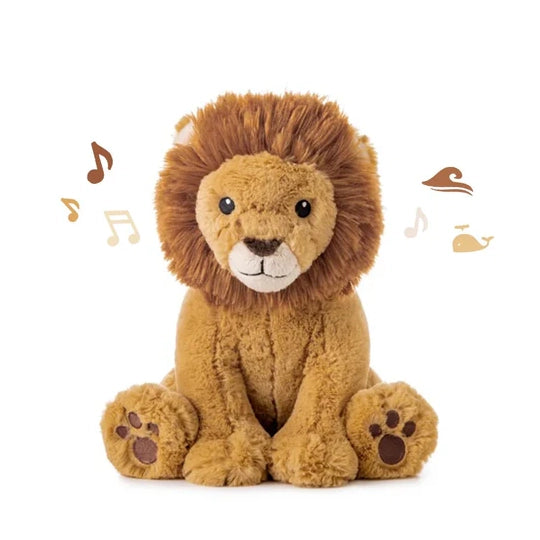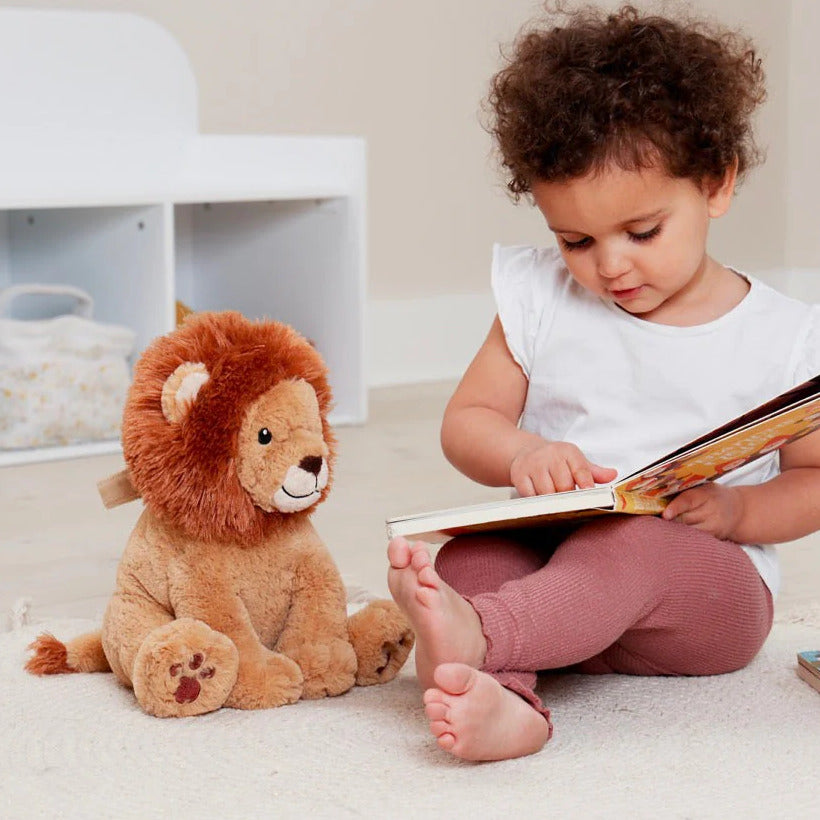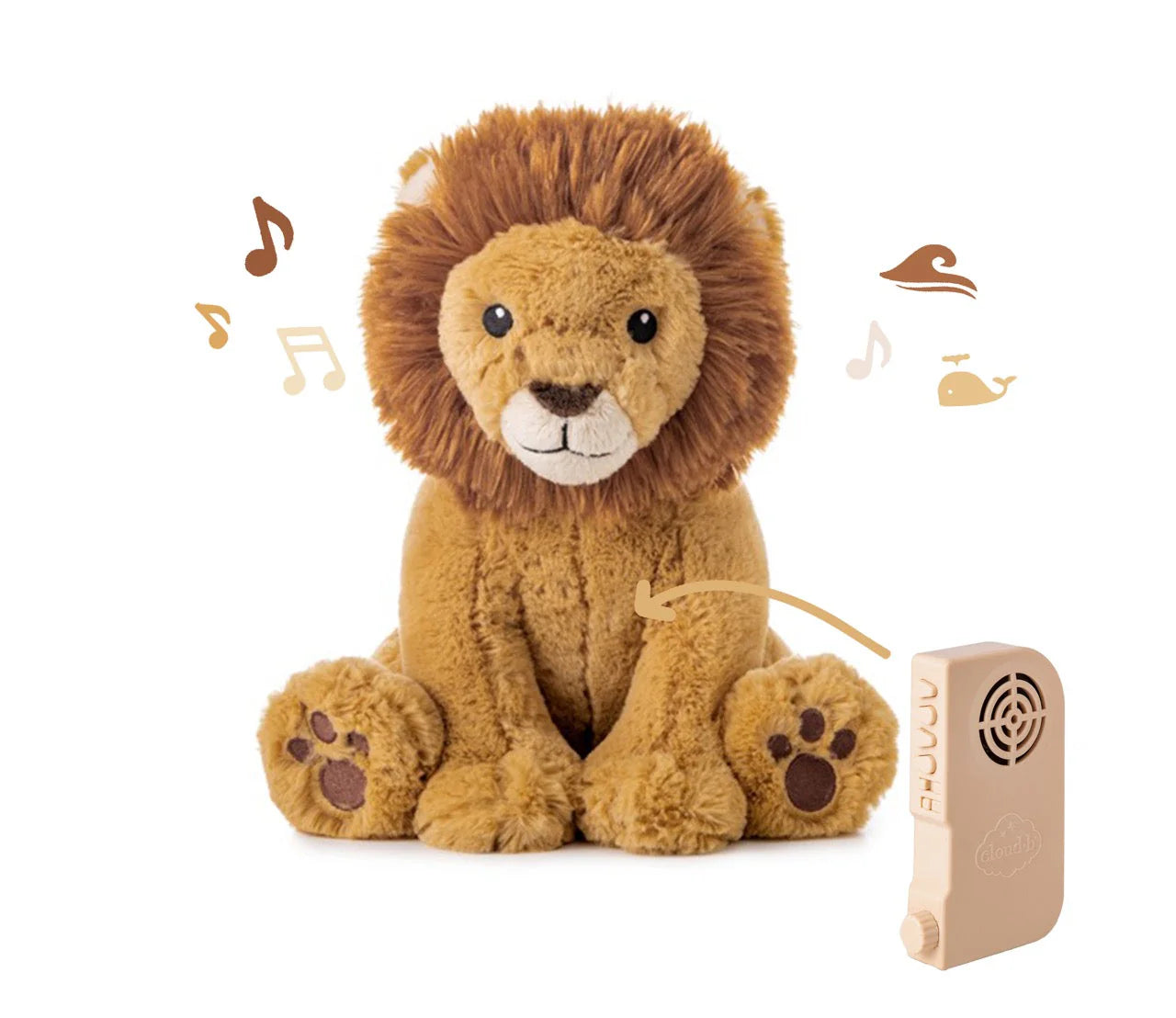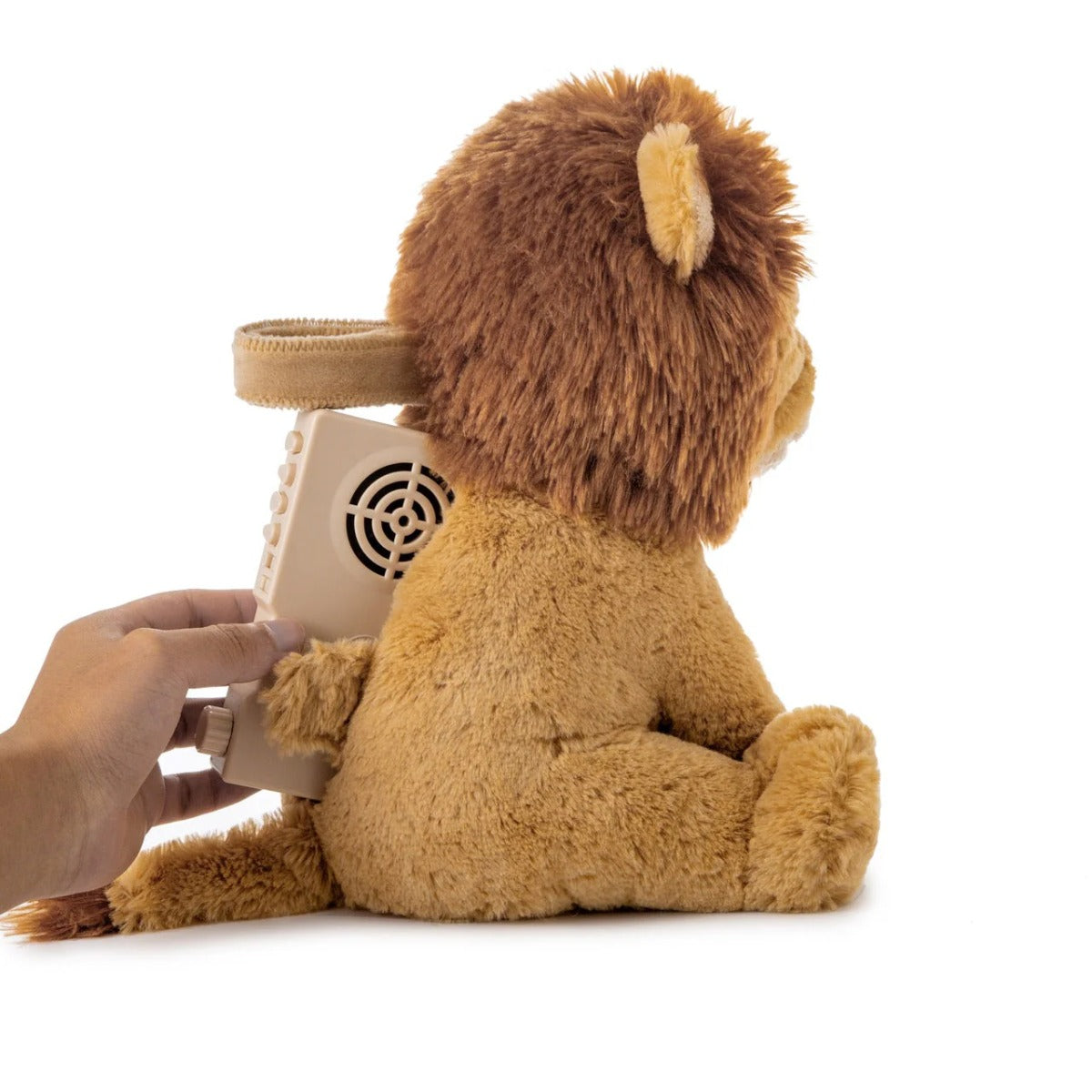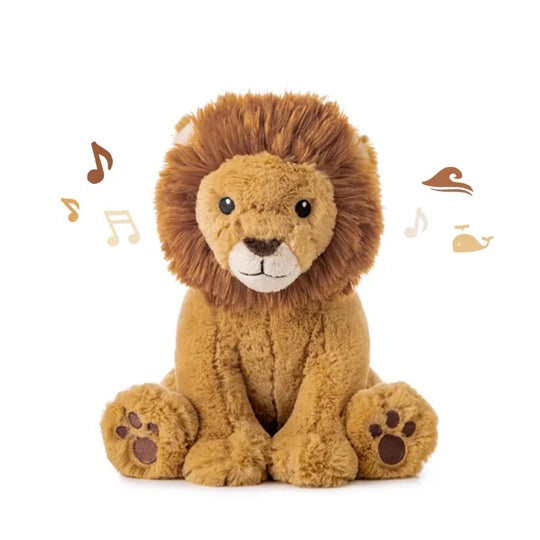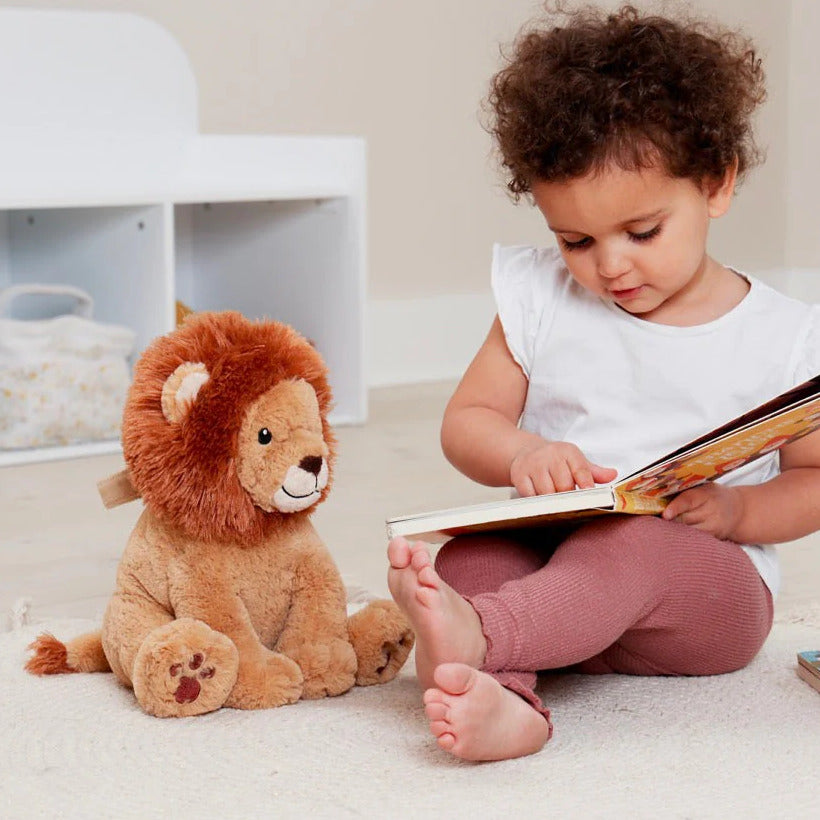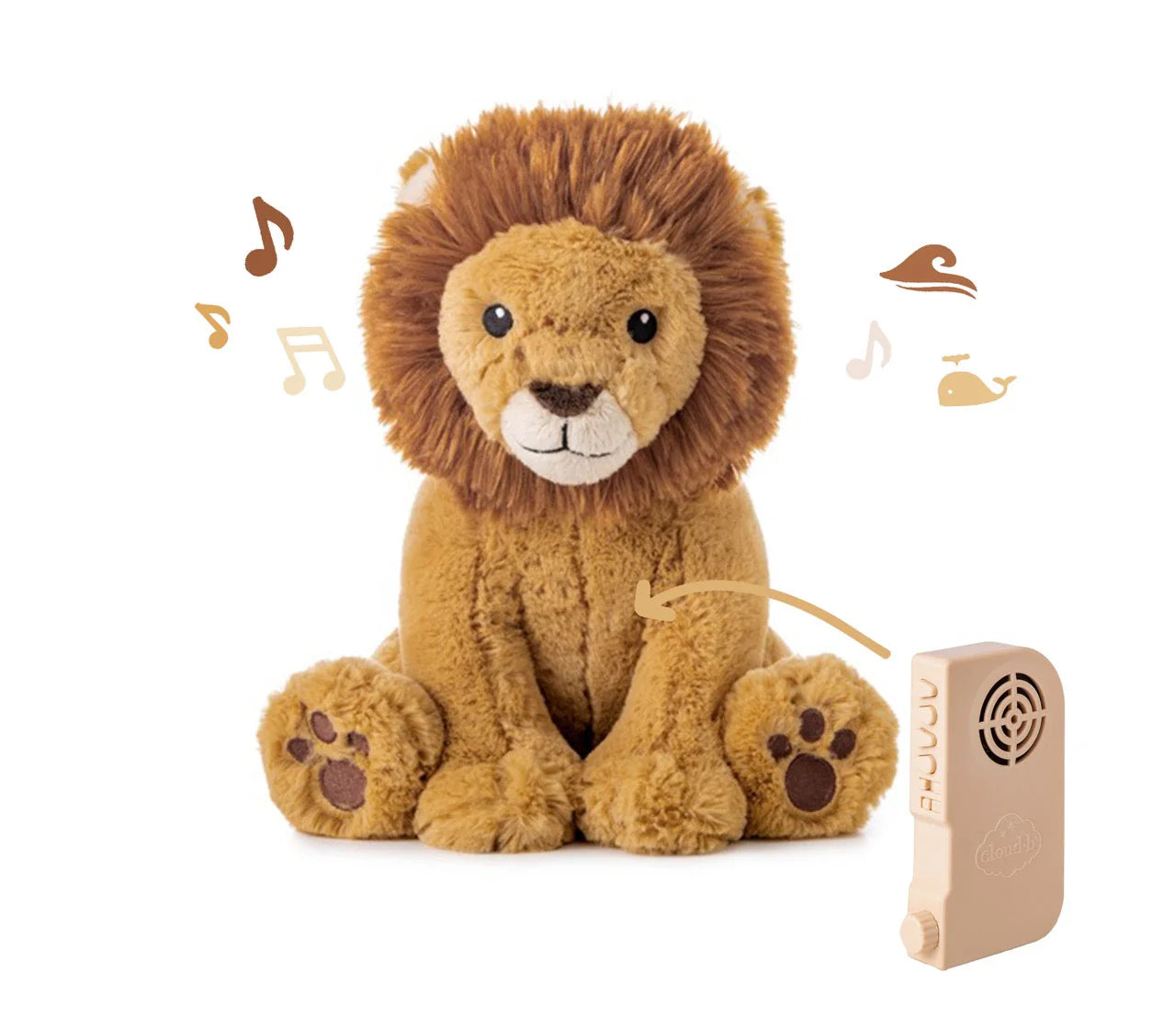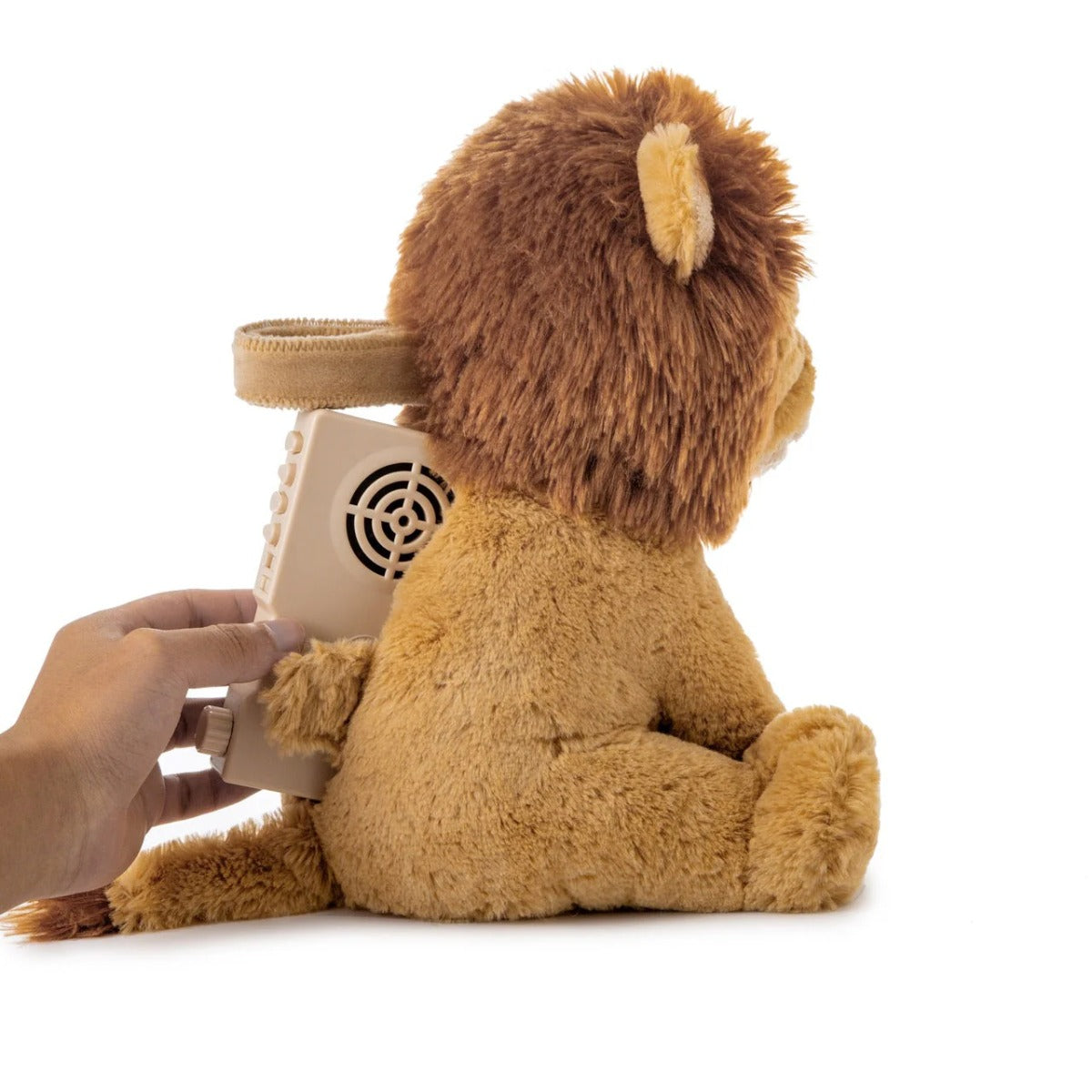Louis Lion Smart Sensor
Louis Lion Smart Sensor
SKU:7801-LI
Clothing Prem to 18 Months
| Size | Age Guide | Weight | Height |
|---|---|---|---|
| Premature | Premature or Small Newborn | Up to 4Kg | Up to 55cm |
| Newborn | 0-3 months | 4-6Kg | Up to 62cm |
| 3 Month | 3-6 months | 6-8Kg | Up to 68cm |
| 6 Month | 6-12 Month | 8-10Kg | Up to 76cm |
| 12 Month | 12-18 Month | 10-12Kg | Up to 84cm |
| 18 Month | 18-24 Month | 12-14Kg | Up to 92cm |
Clothing 2 to 6 Years
| Size | Age Guide | Height | Chest | Waist | Hip |
|---|---|---|---|---|---|
| 2 Year | 2-3 Years | Up to 100 cm | 56 | 51 | 58 |
| 3 Year | 3-4 Years | Up to 105 cm | 58 | 53 | 60 |
| 4 Year | 4-5 Years | Up to 110 cm | 60 | 55 | 62 |
| 5 Year | 5-6 Years | Up to 115 cm | 62 | 57 | 64 |
| 6 Year | 6-7 Years | Up to 120 cm | 64 | 59 | 66 |
Beanie Size Guide
| Size | Head Circumference | Age Guide |
|---|---|---|
| Premature | 31-35 cm | Premature or Small Newborn |
| Newborn | 35-40 cm | Newborn |
| Small | 40-43 cm | 3-6 Months |
| Medium | 43-47 cm | 6-18 Months |
| Large | 47-52 cm | 18-3 Years |
Sunhat Size Guide
| Size | Head Circumference | Age Guide |
|---|---|---|
| Newborn | 37-40 cm | Newborn |
| Small | 40-43 cm | 3-6 Months |
| Medium | 43-46 cm | 6-12 Months |
| Large | 46-49 cm | 12-24 Months |
| Xtra Large | 49-54 cm | 2-4 Years |
Sleep Pods Size Guide
| Size | Weight | Age Guide | Measurement(Back to Hem) |
|---|---|---|---|
| Newborn | 0-6 kgs | 0-3 Months | 60.5 cm |
| Small | 0-8 kgs | 3-6 Months | 66 cm |
Booties Size Guide
| Size | Age Guide |
|---|---|
| Newborn | 0-3 Months |
| Small | 3-6 Months |
| Medium | 6-12 Months |
| Large | 12-18 Months |
Pretty Brave Baby
| Foot Length (mm) | Insole Length (mm) | EU | UK | Age | INT |
|---|---|---|---|---|---|
| 95-104 | 110 | 16/17 | 2 | 0-6m | S |
| 104-114 | 118 | 18 | 3 | 6-12m | M |
| 114-123 | 127 | 19/20 | 4.5 | 12-18m | L |
| 123-137 | 142 | 21/22 | 5.5 | 16-22m | XL |
Pretty Brave 1st Walker
| Foot Length (mm) | Insole Length (mm) | EU | UK | Age |
|---|---|---|---|---|
| 114-120 | 125-128 | 19 | 3 | 1 yr |
| 120-126 | 132-135 | 20 | 3.5 | 1-2 yrs |
| 126-132 | 138.5-141.5 | 21 | 4.5 | 1-2 yrs |
| 132-138 | 145-148.5 | 22 | 5 | 2 yrs |
Crywolf Swim Nappy
| Size | Length (waist to crotch) | Crotch Width (side to side) |
|---|---|---|
| 0-1 yr | 1-2 yrs | |
| 37 | 38 | |
| 14.5 | 15.5 |
Crywolf Rash Suit
| Size | Length (back neck to crotch) | Chest (arm to arm) | Waist (side to side) | Sleeve (neck to cuff) | Neck Opening(diameter) |
|---|---|---|---|---|---|
| 6-12 Months | 1 yr | 2 yrs | 3 yrs | ||
| 40 | 42 | 44 | 46 | ||
| 25 | 26 | 27 | 28 | ||
| 24 | 25 | 26 | 27 | ||
| 30 | 31.5 | 33 | 34.5 | ||
| 13.25 | 13.25 | 13.8 | 14.3 |
In stock
Couldn't load pickup availability
Overview
Overview
Louis Lion™ Smart Sensor - This adorable lion is a white noise plush that plays 8 soothing sounds and melodies!
These soothing sounds help babies and children go to sleep faster. The Louis Lion™ includes a Smart Sound Sensor. If your baby wakes up and makes any sound, the sensor restarts the music to help baby fall back asleep. When bedtime beckons, the plush easily attaches to any crib by using the hook-and-loop fastener behind its head.
Key Features
Key Features
Delivery and Returns
Delivery and Returns
- Delivery: Free within NZ on orders over $100 (excluding bulky items) or $8 standard shipping
- Returns: Accepted within 14 days of receipt with proof of purchase
- Some items are excluded from returns including sale items, hardware, car seats, prams, monitors and personal items - please click here for the full list.
Share this product
Recently Viewed Products
Related Blogs
How to Dress your baby for Sleep
Dressing Your Baby for Sleep – A Seasonal Guide Knowing how to dress your baby at bedtime can feel like a bit of a guessing game – especially when the seasons start to change. Should you add another layer? Is the room too cool? Are their hands meant to be that cold? To help take the guesswork out, we’ve put together a simple guide to dressing your little one for sleep using our Dimples sleeping bags and sleepwalkers, without any additional blankets. A Gentle Reminder Every baby is different, so this guide is just that – a guide. The best way to check if your baby is at a comfortable temperature is by feeling the back of their neck. It should feel warm, not hot or sweaty. Hands and feet can feel cooler and aren't always a reliable indicator. Baby’s body temperature naturally dips during the early morning hours, so if your little one is waking more often than usual, it might be worth checking if they’re feeling a bit chilly. And remember – when it comes to sleep, it’s safer for babies to be slightly cool rather than too warm. Choosing the Right Layers When dressing your baby, natural fibres like Merino wool or cotton are best. These breathable fabrics help regulate temperature and keep your baby comfortable through the night. Merino in particular is a year-round superstar – its clever fibres trap warm air on cooler nights and allow heat to escape on warmer ones, making it ideal for all seasons. At Dimples, all of our garments are designed especially for keeping little ones cosy and safe. We recommend having at least two sleeping bags or sleepwalkers on hand for each season, so you’re always prepared for the inevitable midnight messes. Ideal Room Temperature The ideal temperature for a baby’s room is between 16–20°C. If you’re using a heater or heat pump, setting the thermostat to 18°C will help maintain a steady climate through the night without overheating. Monitoring the Room Many baby monitors display room temperature, which can be a helpful reference.Alternatively, something like the Shnuggle Moon Nightlight can be used to keep an eye on the room temperature. It uses a handy colour display to show whether the room is sitting within the ideal range. Signs Your Baby May Be Too Warm Waking more frequently than usual Sweaty back or neck Damp hair Shallow or rapid breathing If you notice these signs, try removing a layer or adjusting the room temperature. A cool, damp cloth on the back of their neck can help if they’re feeling very warm – and always check for fever if you’re concerned. Signs Your Baby May Be Too Cold Restless sleep or unusual movement around the cot Rolling onto their stomach Catnapping during the day Waking around 5am If any of these sound familiar, consider adding a layer, using a warmer sleeping bag, or gently warming the room. Dressing your baby for sleep doesn’t have to be stressful. With a few key pieces and a little trial and error, you’ll find the sweet spot that keeps them cosy and safe – all night long 😴 Explore our full sleepwear range to find breathable, natural fibre options for every season.And if you’re ever unsure, we’re here to help.
Learn moreMusic for Babies
Is it a myth or a must? You may have heard that Mozart in utero is essential to healthy brain development, and Baby Einstein on repeat will produce an intellectually advanced toddler. But is music for babies really a thing? Exposing babies and toddlers to music might not necessarily be intelligence-inducing, but it definitely has its benefits for both parents and babies. Here’s what the science really says! Music in utero From around 20 weeks into pregnancy, your baby’s ears start functioning – taking in all the familiar and soothing sounds of the womb and the outside world. That might be mum’s favourite music, the sound of her voice or the constant drum of her heartbeat. So, if classical music isn’t your thing, do you need to suffer through it in the later stages of pregnancy to produce a high IQ human? The jury is out on the intellectual impact of womb-tunes, but listening to music with your unborn babe can be a nice way to schedule some regular time to unwind and bond over your favourite melodies. As a bonus, using this time to de-stress gives you a valid excuse to belt out your greatest hits in the shower. If it makes you feel good, chances are your baby will love it too. While it might be tempting to share an earphone with your belly buddy, playing music through your stereo is a much better option. Amniotic fluid acts as a conductor and can make an earphone too loud for tiny ears. If you’re happy and you know it… We all know that music has the magical ability to transform your mood, and it can do the same for babies and toddlers. Even when they’re little, babies sway or bounce to the beat and can be calmed down with their favourite songs. Using the mood-altering magic of music can also be a helpful way to set up routines for babies and get toddlers on board with chores. Upbeat numbers can get things started in the morning, and special bedtime songs signal to toddlers it’s time to wind down and get ready for sleep. Similarly, music can make chores fun. Rather than asking toddlers to tidy up at the end of the day, take a leaf out of the childcare professionals’ books and learn a ‘clean up’ song – less nagging, more dancing! Learning through music Exposing babies and toddlers to music during their early years helps with learning sounds and the meanings of words. Songs like ‘Heads, shoulders, knees and toes’ expand their vocabularies and coordination, while singing the ABCs teaches sounds and early literacy. On the maths front, popular nursery rhymes are full of repetition, a great way for young brains to learn about patterns and what comes next. Lots of nursery rhymes also include numbers – it’s practically maths for babies! Getting physical Getting their tiny groove on helps toddlers build key motor skills like jumping, balancing and clapping. Body and mind work together as they move to the beat. Spatial awareness and social skills are also learnt through movements like dancing – avoiding bumps and noticing how other toddlers move in group settings. Music for bonding Life as a new parent can be all go, so it’s nice to schedule some regular bonding time and fun with music. If you feel lacking in the creative department, check out what’s on offer at your local library or church – many offer preschool music sessions which double as a great (and easy) opportunity for new mums to escape the house. Ears and imaginations Is there anything better than a toddler who is good at listening? Music cues toddlers to move and react, a great way to develop early listening skills. Similarly, songs that call for them to stomp like a dinosaur or snap like a crocodile sharpen their ability to listen and exercise their creative brains. The best musical instruments for your mini maestro Music doesn’t need to be expensive and can easily cost nothing. Aside from singing (free), other beats like clapping, clicking fingers or stomping are easy (and also free) ways to create music at home. Once you’ve exhausted those, there are plenty of things around the home that can make a serious sound – a good old wooden spoon and pot, or clanging two pot lids together. Looking for something slightly more tuneful? The best instruments for little fingers are things that can be hit or shaken. Think soft rattles for babies, simple wooden drums, maracas or xylophones. Music to your ears The good news is, there’s no real evidence that one type of music is better for your baby’s development than another – but there is evidence that music is a good thing overall. All that really matters is that you’re having fun and enjoying music with your little one. Because if you’re happy (and you know it), chances are your baby will be happy too!
Learn moreTop Ten Tips for a Successful Naptime
Naps are more challenging than night sleep but can be done. Napping is incredibly important, not just for your baby’s wellbeing, but for yours too. When naps are too short, erratic or unpredictable, it can be frustrating, worrying and exhausting. If you’re struggling to get your baby or toddler to nap, these ten tips could help. 1. Look out for sleep cues Ideally, your baby will be ready for sleep, but not overtired which can make napping harder. Keep an eye out for signals like frowning, jerky movements, scratching their ears or head, or making grunting noises. Toddlers may get sillier, louder, or easier to upset. 2. Skipping a nap won’t make for better sleep later Don’t skip a nap with the hope that your baby will have a better sleep later. Missing a nap will lead to overtiredness, making napping even harder. If your child has skipped a nap, they might need to go to bed earlier to make up for it. 3. It’s ok to try later If your baby is point-blank refusing to nap, it’s ok to take a break. Try pausing, and doing something else with them. If you’re following a sleep-training technique or trying to break a sleep habit, it’s ok to revert to what you know will work – you can try again when your baby is no longer overtired. 4. Avoid device screens TV, computers and other devices with screens emit blue light, which can disrupt melatonin production – the hormone that makes people feel sleepy. Watching TV up to 90 minutes pre-nap can lead to less nap time, or missing sleep altogether. This can add up to a sleep deficit, which can make the problem worse. Keep screen time to a minimum and after nap time only. 5. Develop a schedule You need to find a balance between naps and feeding, so your baby isn’t waking up because of hunger. To maximise sleep it’s also important that there is enough (but not too much!) time between sleeps. For many parents, a schedule makes this easier. Every child is different, but this sleep and feeding schedule will help give you an idea of what could work. 6. Have a pre-nap routine Bedtime routines are important – and naps need them too. Create a short pre-nap process that is a pared-back version of what you do at night. It should be cosy and relaxing, preparing your child for her nap. 7. Keep the light low and encourage quietness Your baby will find it easier to fall asleep and stay that way in a cool, dark, quiet room. To create this ideal sleep environment, check the room isn’t too hot – between 18 and 21 degrees Celsius is ideal. Hang blackout drapes, and use white noise to block out sudden noises. 8. Consistency is key Aim for at least one nap at home during the day – ideally the first of the day. If you’re out and about, the naps aren’t as restful as ones at home, which will lead to your baby becoming overtired. 9. If your baby stops napping, don’t panic Your baby can stop napping for many reasons – illness, teething, a sleep regression, a growth spurt, a developmental leap, or a change in napping schedule. During sleep regressions, your baby or toddler will change their sleeping patterns for the worse. This is exhausting and stressful, but it’s normal. This regressions generally align with big developmental leaps, around 4 months, 8 months, 11 months, 18 months, and 2 years. Nap transitions are when a child’s sleep needs change. Commonly newborns will nap 4-5 times a day, which drops to 4 at about four months old. Then, from 5-8 months, they’ll have around three naps and start resisting the fourth. From 9-18 months this will reduce to two naps a day, and you can expect your child to continue having one (ever shorter!) nap a day until they're about 3. 10. Be kind to yourself Naps are notoriously tricky to manage – your baby won’t have the same sleep pressure during the day as they have at night, so even small things can throw you off course. Like everything else involving babies, be patient with yourself and them. What’s ‘normal’ won’t work for everyone, so give yourself permission to have a bit of trial and error, and allow gentle deviations from the routine when required. Persistence, flexibility and support Naptime doesn’t have to be a struggle. Keep an eye out for sleep regression or nap transitions, and adjust schedules accordingly. Keep persisting, ask your friends and family for help and support, and pay attention to your baby’s natural tendencies. Before long, nap time will be something to look forward to!
Learn moreWhat you need to know about baby monitors
Keep your eye on bubs while they're fast asleep Becoming a parent is a rollercoaster of emotions and new experiences. You’ve spent nine months with your baby tucked safely in your belly, and now that they've made it Earth-side, you can’t wait to bring them home. When it comes to sleeping, you may have your mini-me in your room or nursery. At some point they will move into their own bedroom, and it’s quite natural to feel anxious about leaving your tiny human alone. That’s where baby monitors allow you to keep an eye and ear on your little one from anywhere in the house (outside too!). Baby monitors provide peace of mind for parents who worry that they might not wake when baby stirs or cries, signaling it’s time for a feed – or perhaps just stretching. In today’s tech-driven world, baby monitors are almost a given, and these days they come with lots of features. Here’s what you need to know when buying a baby monitor: Types of baby monitors Audio Sound-only monitors are essentially like a walkie-talkie – they’ll let you listen to your baby as they sleep. They focus on minimising background noise so you can hear cries and coos from the crib. Many audio monitors will light-up when your baby stirs, glowing brighter as their cries get louder. Video and audio Watch your baby – as well as hear them! These monitors work through a small camera mounted on the nursery wall or a flat surface beside baby’s crib. Night vision provides a clearer image when the lights are off, and touch-screen features let you zoom in or tilt the camera. Some can feed a live stream to multiple cameras, helping you keep an eye out from any room in the house. Wireless network Most monitors use radio-frequency transmission, but these digital monitors connect to your home Wi-Fi or mobile network. For example, the Owlet Cam lets you stream audio and high-definition video of your baby directly to your smartphone via the Owlet app. Some will send your device notifications when there has been a change in movement or sound. Key baby monitor features Like many technology-based products, baby monitors have advanced in leaps and bounds. Some have amazing add-ons which certainly make life easier, but there are some essential features you should consider: Rechargeable batteries . Pick a model that can recharge or be plugged in instead of relying on batteries.= Low-battery indicator . You can visually see when power is running low. Multiple and portable receivers . You may want a receiver that can move around the home with you. An extra handset is handy for when the other one is charging. Night vision. Unless you can see in the dark, a monitor with night vision will make it easier to see your sleeping baby – no matter what time of day or night it is. Light-up sound indicator . Look for a baby monitor with a light-up sound indicator, so if you’re on the phone, in a noisy room or don’t want to wake another sleeping family member, you can visually monitor your little one’s noise level. Sound and video interference filters . Background noises can make it difficult to hear your baby – and they’re not pleasant when amplified by a baby monitor. A sound activation feature will filter out white noise – and turn on when it detects your baby crying. DECT technology . Baby monitors that use common radio frequencies will pick up signals and interferences from all over the neighbourhood – not ideal. Digital enhanced cordless telecommunication devices (DECT) are more private because the frequency is less common than in other devices. Movement and room temperature sensors . This feature sounds an alarm when there has been no movement after a certain length of time, and when the room temperature goes above or below the range it has been set at. Talk-to-baby feature . Essentially like an intercom – this lets you soothe your baby from another room or communicate with your husband or wife when they’re with your little one. Lullaby and night light . Some monitors will play a tune to help your baby get to sleep. Some will also give off a soft glow which babies can find comforting in a dark room. Camera angle and mount . For monitors with video capabilities, consider where you want to place the camera (on a flat surface, in a clamp, on the wall) and whether you can remotely control the viewing angle. Multiple camera support . Set up multiple rooms with cameras that you can turn on or off as needed. Get a good night’s rest – sort of Being a parent can be stressful enough without running back and forth to check on your sleeping baby – especially at two AM! For some, a baby monitor might not be necessary – if your home is small for example – but parents looking for peace of mind should consider using one. There are models available that offer a combination of features, like Oricom’s Smart HD Dual Camera Baby Monitor . The smart baby monitor features dual lenses for standard and wide-angle viewing. Simply pair the camera to the FREE HubbleClub for Partners app, and you can view both feeds simultaneously on your smart device. Lull your little one to sleep with pre-loaded nature sounds, lullabies & audiobooks, soothe them with your familiar voice using Two-Way Talk, and even track nursery room temperatures with the touch of a button to ensure your newborn is always comfortable. The Oricom HD Dual Camera shoots in 1080p HD and with pristine infrared night vision, this baby monitor provides crystal clear monitoring, even in total darkness. The OBHDUAL is the reliable friend that makes bedtime easier for the whole family, with the camera feed viewable on your Smart Device at home (not included).
Learn more

